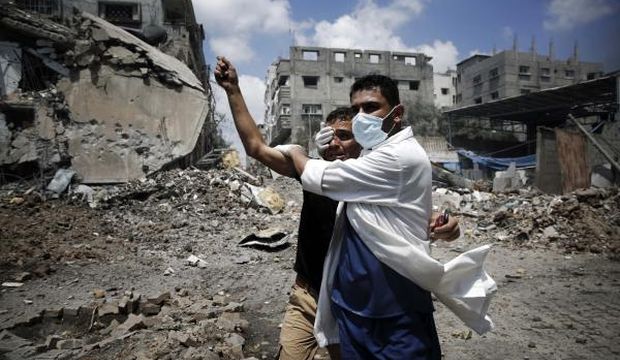
A medic helps a Palestinian in the Shejaia neighbourhood of Gaza City, which was heavily shelled by Israel during fighting, on July 20, 2014. (Reuters/Finbarr O’Reilly)
Gaza, Asharq Al-Awsat—Palestinians who fled the Israeli bombardment of the Shejaia district of Gaza City on Sunday have spoken to Asharq Al-Awsat of their ordeal as they fled to safety.
At least 87 Gazans were killed on Sunday—60 of them in the district of Shejaia alone, reportedly including 17 children, 14 women, and four elderly people. It has been the deadliest day since the outbreak of the current hostilities which have so far killed more than 500 Gazans, according to the Palestinian authorities.
Speaking to Asharq Al-Awsat, Mohammed Muhaisin, a 39-year-old Gazan, said the bombardment had been so intense that during their journey he did not think that he, together with his wife and his six children, would reach the Midan Falasteen (Palestine Square) area unhurt.
Muhaisin is one of tens of thousands of Shejaia residents who fled their homes after the Israeli military began shelling the district, northeast of Gaza City, in the early hours of Sunday.
Muhaisin said his family had walked over 2.5 miles (4 kilometers) while under fire to get to the closest safe-point.
He told Asharq Al-Awsat that mortar shells hit all the district’s main and side streets, which were strewn with dead bodies and human remains lying outside buildings reduced to rubble by the bombardment.
“Children, women . . . all were turned into dismembered body parts,” a shocked Muhaisin said.
He added that he believed the Israeli army had deliberately targeted citizens inside their homes to force them outside before targeting them again directly when they tried to escape to safe areas.
Speaking to Asharq Al-Awsat, Muhaisin’s wife said that they had sheltered under the stairs of their house on the night of what she described as “a massacre.” She added that more than 30 shells fell outside their home, and a state of panic had gripped her and her children, who were screaming because of the heavy shelling.
She said: “As soon as daylight broke . . . we left our house amid strong mortar fire. We found thousands of people leaving as well. We survived miraculously. We expected to be hit because of the amount of mortar shells fired. I cannot believe until this moment that I and my children have come to a safe place.”
“We saw dozens of dead bodies lying on the ground. We could not do anything . . . Heads of martyrs were blown off their bodies. We saw horrific and appalling scenes,” she added
Atef Al-Mughni, a citizen who fled the area to the Al-Shifa Hospital compound in central Gaza City, over 3 miles away from Shejaia, told Asharq Al-Awsat that the moment he ran out of his house he found six dead bodies lying on top of each other.
He said he had sent his family to stay with his wife’s family in the Al-Nusayrat district in the Gaza Strip after receiving Israeli warnings to leave. He was on his own in the house when the heavy bombardment started.
“I would not be exaggerating when I say that more than 1,000 mortar shells slammed into the district in the course of just five hours. But the shelling reached each square meter in the area until it was reduced to debris. Dozens of people were martyred in their houses and others were martyred while trying to escape on Sunday morning,” he said.
According to Palestinian security sources, no less than 700 mortar shells were fired at Shejaia in the course of four hours, reaching their peak between 2:30 am and 4 am on Sunday. Israeli forces then resumed their bombardment of the district with more than 200 mortar shells the moment citizens left their houses in search of safe areas, the sources added.
According to assessments, Israeli artillery was firing more than two shells per minute.
Um Tayseer Salim told Asharq Al-Awsat that the scenes of citizens fleeing their homes reminded her of stories she had heard from her parents about the flight of Palestinians in 1948.
“We fled our houses without taking anything with us. We went out and we all lost hope that we could survive. The scene was horrific. It looked like there had been a strong earthquake in the area that reduced it to ruins,” she said.
“What happened to us was a massacre. They have destroyed everything and killed our children. We could not identify the martyrs . . . There were burnt bodies. Where is the world? Where are the Arabs? They have subjected us to another Sabra and Shatila [massacre],” she wept.
According to official statistics from the UN Relief and Works Agency (the UN agency that aids Palestinian refugees), more than 35,000 Palestinian families have fled the Shejaia district and its suburbs and have headed toward schools affiliated to the organization in search of shelter.
